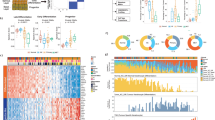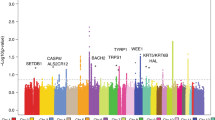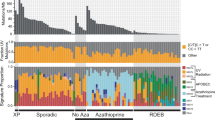Abstract
The MSSE gene predisposes to multiple invasive but self-healing skin tumours (multiple self-healing epitheliomata). MSSE was previously mapped to chromosome 9q22–q31 and a shared haplotype in affected families suggested a founder mutation. We have refined the MSSE critical region (<1 cM, <1 Mb) between the zinc-finger gene ZNF169 and the Fanconi anaemia gene FANCC. By genetic mapping we have excluded ZNF169 and FANCC as well as PTCH (PATCHED) and TGFBR1 (transforming growth factor beta receptor type-1) genes. The CDC14B cell cycle phosphatase gene also lies in the region but screening of the complete coding region revealed no mutation in MSSE patients. Somatic cell hybrids created by haploid conversion of an MSSE patient's cells enabled screening of the MSSE chromosome 9 and showed no CDC14B deletion or mutation that abrogates CDC14B mRNA expression. Thus, CDC14B is unlikely to be the MSSE gene. We also report the first molecular analysis of MSSE tumours showing loss of heterozygosity of the MSSE region, with loss of the normal allele, providing the first evidence that MSSE is a tumour suppressor gene.
This is a preview of subscription content, access via your institution
Access options
Subscribe to this journal
Receive 50 print issues and online access
$259.00 per year
only $5.18 per issue
Buy this article
- Purchase on Springer Link
- Instant access to full article PDF
Prices may be subject to local taxes which are calculated during checkout



Similar content being viewed by others
References
Ahmadian A, Ren ZP, Williams C, Ponten F, Odeberg J, Ponten J et al. (1998). Oncogene 17: 1837–1843.
Byrom J, Mudaliar V, Redman CW, Jones P, Strange RC, Hoban PR . (2004). Int J Oncol 24: 1271–1277.
Chadwick BP, Heath SK, Williamson J, Obermayr F, Patel L, Sheer D et al. (1998). Genomics 47: 58–63.
Chadwick BP, Obermayr F, Frischauf AM . (1997). Genomics 41: 390–396.
Chatterjee TK, Eapen A, Kanis AB, Fisher RA . (1997). Genomics 45: 429–433.
Croce CM, Calin GA . (2005). Cell 122: 6–7.
Demetrick DJ, Zhang H, Beach DH . (1996). Cytogenet Cell Genet 73: 250–254.
Eichler EE, Clark RA, She X . (2004). Nat Rev Genet 5: 345–348.
Farndon PA, Morris DJ, Hardy C, McConville CM, Weissenbach J, Kilpatrick MW et al. (1994). Genomics 23: 486–489.
Feinstein E, Druck T, Kastury K, Berissi H, Goodart SA, Overhauser J et al. (1995). Genomics 29: 305–307.
Gailani MR, Stahle-Backdahl M, Leffell DJ, Glynn M, Zaphiropoulos PG, Pressman C et al. (1996). Nat Genet 14: 78–81.
Gong YQ, Chitayat D, Kerr B, Chen TP, Babul-Hirji R, Pal A et al. (1999). Am J Hum Genet 64: 570–577.
Goudie DR, Yuille MAR, Leversha MA, Furlong RA, Carter NP, Lush MJ et al. (1993). Nat Genet 3: 165–169.
Griffiths-Jones S . (2004). Nucleic Acids Res 32 (Database Issue): D109–D111.
Holmberg E, Rozell BL, Toftgard R . (1996). Br J Cancer 74: 246–250.
Jorgenson E, Tang H, Gadde M, Province M, Leppert M, Kardia S et al. (2005). Am J Hum Genet 76: 276–290.
Kong A, Gudbjartsson DF, Sainz J, Jonsdottir GM, Gudjonsson SA, Richardsson B et al. (2002). Nat Genet 31: 241–247.
Kong X, Murphy K, Raj T, He C, White PS, Matise TC . (2004). Am J Hum Genet 75: 1143–1148.
Levanat S, Chidambaram A, Wicking C, Bray-Ward P, Pressman C, Toftgard R et al. (1997). Cytogenet Cell Genet 76: 208–213.
Li LW, Ernsting BR, Wishart MJ, Lohse DL, Dixon JE . (1997). J Biol Chem 272: 29403–29406.
Li LW, Ljungmann M, Dixon JE . (2000). J Biol Chem 275: 2410–2414.
Martignetti JA, Gelb BD, Pierce H, Picci P, Desnick RJ . (2000). Genes Chromosomes & Cancer 27: 191–195.
Nishiu J, Tanaka T, Nakamura Y . (1998). Genomics 52: 378–381.
Nishiwaki T, Daigo Y, Kawasoe T, Nakamura Y . (2000). Genes Chromosomes & Cancer 27: 169–176.
Richards FM, Goudie DR, Cooper WN, Jene Q, Barroso I, Wicking C et al. (1997). Hum Genet 101: 317–322.
Savoia A, Centra M, Ianzano L, deCillis GP, Buchwald M, Zelante L . (1996). Mol Cell Probes 10: 213–218.
Slaugenhaupt SA, Blumenfeld A, Liebert CB, Mull J, Lucente DE, Monahan M et al. (1995). Genomics 25: 730–732.
Suzuki M, Watanabe TK, Fujiwara T, Nakamura Y, Takahashi E, Tanigami A . (1999). J Hum Genet 44: 300–303.
Wicking C, Breen M, Negus K, Berkman J, Evdokiou A, Cowled P et al. (1995). Cytogenet Cell Genet 68: 119–121.
Zaphiropoulos PG, Toftgard R . (1996). DNA Cell Biol 15: 1049–1056.
Zhao W, Hisamuddi IM, Nandan MO, Babbin BA, Lamb NE, Yang VW . (2004). Oncogene 23: 395–402.
Acknowledgements
We are grateful to all the MSSE families for their cooperation. We thank Professor Peter Farndon, Professor Sue Povey, Dr Roy Palmer, Dr Colin Arlett, Dr Arjida Woollons, Dr Anne-Marie Gerdes, Sean Humphray and dermatologists from across the UK for information and samples used in this study. This work was funded by the Medical Research Council and Tenovus, UK.
Author information
Authors and Affiliations
Corresponding author
Rights and permissions
About this article
Cite this article
Bose, S., Morgan, L., Booth, D. et al. The elusive multiple self-healing squamous epithelioma (MSSE) gene: further mapping, analysis of candidates, and loss of heterozygosity. Oncogene 25, 806–812 (2006). https://doi.org/10.1038/sj.onc.1209092
Received:
Revised:
Accepted:
Published:
Issue Date:
DOI: https://doi.org/10.1038/sj.onc.1209092
Keywords
This article is cited by
-
Multiple Self-Healing Squamous Epithelioma (MSSE): Rare Variants in an Adjacent Region of Chromosome 9q22.3 to Known TGFBR1 Mutations Suggest a Digenic or Multilocus Etiology
Journal of Investigative Dermatology (2013)
-
Multiple self-healing squamous epithelioma is caused by a disease-specific spectrum of mutations in TGFBR1
Nature Genetics (2011)
-
Multiple Self-Healing Squamous Epithelioma in Different Ethnic Groups: More than a Founder Mutation Disorder?
Journal of Investigative Dermatology (2007)



